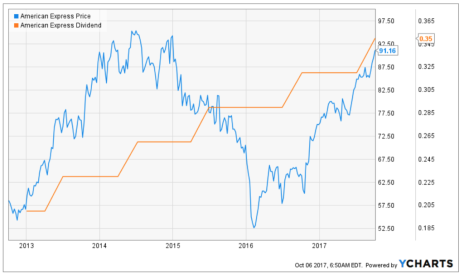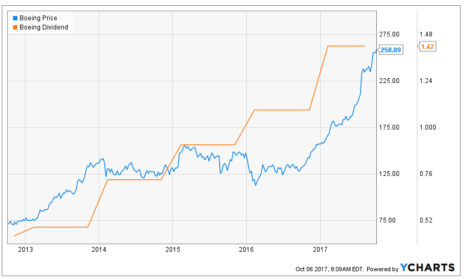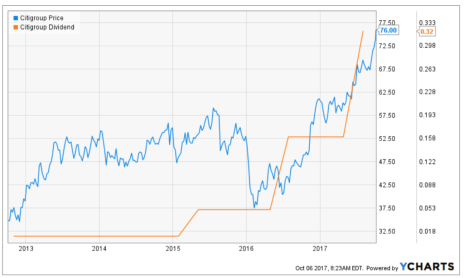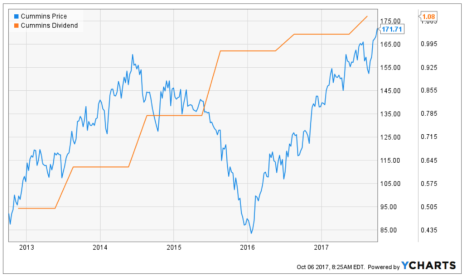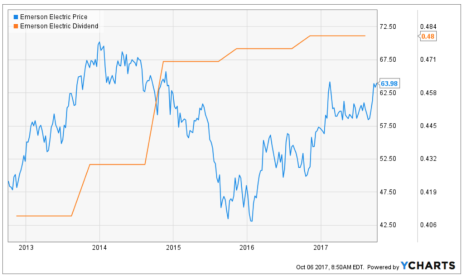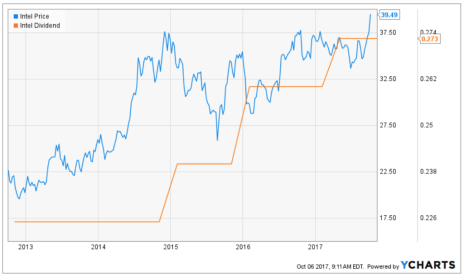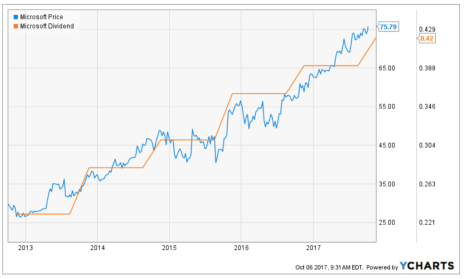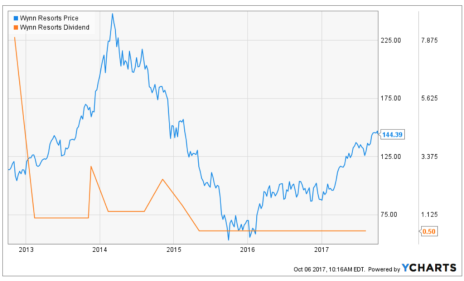The best dividend-paying stocks can help you reach a variety of investment goals, including protecting your wealth, generating income and reaping capital gains. If your goals include price appreciation, regular income and rising dividends, you’re a dividend growth investor. Dividend growth investors seek out dividend stocks with growing earnings and positive technical momentum that also increase their dividend payouts every year.
Here are my 10 best dividend-paying stocks for investors who want both income and growth.
(After you read this article, be sure to also check out my lists of the Best High Yield Dividend Stocks and the Best Dividend Stocks to Buy and Hold.)
Best Dividend-Paying Stocks for Dividend Growth Investors
- American Express Company (AXP)
- Boeing (BA)
- Broadridge Financial (BR)
- Citigroup (C)
- Cummins (CMI)
- Emerson Electric (EMR)
- Intel (INTC)
- Microsoft (MSFT)
- Packaging Corp. of America (PKG)
- Wynn Resorts (WYNN)
Best Dividend-Paying Stock #1: American Express Company (AXP)
Dividend Yield: 1.5%
American Express is well-known for its credit cards, which are popular with higher-end consumers and businesses. Earnings and revenues are growing thanks to increased spending on its cards and rising credit card balances. Analysts expect revenues to rise 3% this year and 5% next year. EPS are only expected to increase 2% this year, but analysts expect much stronger growth going forward: estimates average 11% for next year and 12% over the next five years.

Get My Free Report Now

Get My Free Report Now

Get My Free Report Now

Get My Free Report Now
AXP’s dividend should grow even faster. The company has been under the thumb of financial regulators since the 2008 financial crisis, thanks to its designation as a “systemically important financial institution.” That means regulators limit how much cash American Express can return to shareholders, and the company had to freeze its dividend from 2008 to 2011. However, strong “stress test” results allowed American to start increasing its dividend again in 2012, and management has boosted the dividend by over 75% since then. American’s dividend payout ratio is still low though (about 24% currently), leaving plenty of room for additional growth. The company is also spending more on share buybacks, and recently received authorization to buy back an additional $4.4 billion over the next four quarters.
Best Dividend-Paying Stock #2: Boeing (BA)
Dividend Yield: 2.2%
Seattle-based Boeing makes military and commercial aircraft. Business is booming, thanks to strong demand from airlines in the U.S. and abroad. Free cash flow has grown by 6% per year in each of the last five years (on average), and EPS have risen by an average of 8% per year. Earnings have beaten estimates in each of the last four quarters, and growth estimates are trending steadily upwards. Analysts now expect EPS to grow a whopping 38% this year, and 8% next year.
Boeing gets about one-third of revenue from its Defense and Space & Security division. Those big government contracts add consistency to revenues, and could add a kicker to growth if U.S. defense spending increases significantly under President Trump.
Boeing is a champion of rewarding investors. Over the past five years, the company has increased its dividend by nearly 20% per year, while reducing its share count each year.
The stock is pretty rewarding too. After breaking out of three-year trading range to the upside in January 2017, BA has gained 66% this year, and is trading at all-time highs.
Best Dividend-Paying Stock #3: Broadridge Financial (BR)
Dividend Yield: 1.8%
Though it has the word “financial” in its name, Broadridge is actually a tech company, providing solutions to the financial industry. The company has a wide variety of tools that financial professionals use for everything from securities analysis to expense management. Broadridge also provides investor communications services, like distributing quarterly reports and processing proxy votes. Broadridge is constantly investing in new technologies, which both attracts new customers and consistently increases revenue-per-customer.
Broadridge delivers consistent EPS growth, averaging 26% per year over the past five years. Management has focused on growing recurring revenues in recent years, largely through acquisitions, to improve the stability of earnings even further. Analysts expect revenues to increase 3% this year and 4% next year, driving 19% and 10% EPS growth.
Broadridge makes paying “a meaningful dividend” a high priority, and aims for a dividend payout ratio of at least 45% (based on prior year net earnings). The company has paid dividends consistently since its IPO in 2007, and has increased the dividend for nine years running. Over the past five years, the dividend increases have averaged 16% per year.
And the stock is in a strong, steady uptrend, and just broke out to new all-time highs in September.
Best Dividend-Paying Stock #4: Citigroup (C)
Dividend Yield: 1.7%
Citigroup (C) was one of the banks hit worst by the financial crisis. Citi has spent the years since the crisis raising capital, recruiting talent, buying back shares and expanding internationally. Today, only 47% of the bank’s revenues come from North America, an advantage given still-low U.S. interest rates.
Citi’s transformation was recognized by the U.S. government this summer, when regulators gave the bank permission to double its dividend and increase share buybacks by more than $15 billion.
That huge dividend hike is likely only the start, and investors have been piling into the stock in anticipation of more growth ahead. That helped C break out of a four-year trading range earlier this year, and the stock is currently trading at its highest level since 2008. Analysts expect revenues to rise 2% this year and 4% next year, fueling 10% and 14% EPS growth.
Best Dividend-Paying Stock #5: Cummins (CMI)
Dividend Yield: 2.5%
Cummins makes engines. The company’s powerful diesel and natural gas engines are used in trucks, busses, heavy-duty construction and mining vehicles, farm vehicles, military vehicles, ships, locomotives and pickup trucks. About 58% of revenue comes from the U.S. and Canada. Demand for Cummins’ products is driven by the U.S. trucking industry and by global construction and industrial production (especially in China and India).
Revenues peaked in 2014, thanks to strong trucking activity in North America. But a global economic slowdown and the strengthening dollar delivered a big hit to sales in 2015, and Cummins missed estimates badly in the third and fourth quarters. Revenues and earnings both stopped growing and started declining. In 2016, international demand started to improve, but U.S. trucking slowed, and sales and earnings fell for a second year in a row.
The company shifted its focus to improving profitability, and managed to beat expectations in each quarter of 2016, despite continuing sales declines. Now, sales have started rising again, and analysts have been increasing their growth estimates quickly. Analysts now expect sales to increase 11% this year, and another 5% next year. EPS are expected to increase 18% this year, and 11% next year. The stock has been rising equally quickly, and just broke out to new all-time highs this month.
Cummins aims to return about half of operating cash flow to shareholders, and continued to increase the dividend even as earnings shrank over the past couple years. That drove CMI’s dividend payout ratio to 57% last year, quite a bit above its historical average of 23%. It’s now coming down as earnings start to rebound, and I expect dividend growth will accelerate over the next couple years.
Best Dividend-Paying Stock #6: Emerson Electric (EMR)
Dividend Yield: 3.0%
Emerson Electric is an industrial conglomerate with a high 3% yield. The company just went through a multi-year restructuring to divest itself of small interests and focus on two core businesses. The first, Commercial & Residential Solutions, includes heating and cooling systems, construction and plumbing tools, ceiling fans and more. Offerings of Emerson’s other core business, Automation Solutions, include industrial equipment and consulting services. Customers include the auto, energy, marine and medical industries, among others.
Emerson has paid a dividend since 1957 and has increased the dividend every year for 60 years, making the company a “Dividend Aristocrat.” Dividend increases were de-prioritized during the restructuring, as you can see in the graph above. But growth is returning: analysts expect Emerson to deliver 4% EPS growth this year and 11% growth next year. That should translate into faster dividend growth as well.
Best Dividend-Paying Stock #7: Intel (INTC)
Dividend Yield: 2.8%
Processors are the name of the game for Intel. The company had a slow few years recently, falling behind its peers in technology adapted for the cloud and mobile devices. INTC stock stagnated for most of the last three years. But that’s now changing: Intel acquired Mobileye this summer, giving the company a lead in self-driving car technology. In September, Tesla (TSLA) announced it is switching from Nvidia (NVDA) to Intel processors for its infotainment systems. Also last month, the company revealed a game-changing new desktop processor. A few days later, INTC broke out to a new 10-year high.
In other words, though it still has shortcomings in a few areas, Intel has quickly become the technology leader in some of today’s fastest-growing computing markets.
Analysts expect revenues to rise 3% this year and next, fueling EPS growth of 11% and 3%. Over the next five years, earnings are expected to grow by about 9% per year. Even better, margins are rising, while the company’s payout ratio has remained in the 40% range.
Plus, INTC is cheap: the stock trades at a P/E of 15, and a forward P/E of only 13.
Best Dividend-Paying Stock #8: Microsoft (MSFT)
Dividend Yield: 2.2%
As one of the oldest tech giants, Microsoft has a much stronger dividend history than many of its peers: the company has paid dividends since 2003 and increased its dividend in each of the past 13 years. Today, Microsoft’s dividend is nearly double what it was five years ago.
And the company is still growing. Analysts expect 8% sales growth this year and next. Earnings are expected to decline slightly this year, but next year’s growth estimates average 13%.
The stock is no slouch either, rising 72% since the current uptrend started in 2015.
Best Dividend-Paying Stock #9: Packaging Corp. of America (PKG)
Dividend Yield: 2.2%
A cardboard box company might not sound like much of a growth story to you. After all, Cabot’s growth stock criteria specifically tells investors to look for companies with revolutionary new products that address mass markets.
But while cardboard boxes might not be exactly revolutionary, demand for them is skyrocketing… thanks to Amazon. If you’re like most Americans, you probably now receive and recycle dozens of cardboard boxes a year. That’s great news for Packaging Corp. of America, which makes cardboard boxes, as well as other corrugated containers, packaging materials and displays.
The Amazon effect has driven PKG stock to an all-time high, and the company has increased its dividend by 152% over the past five years. Analysts expect revenues to rise 3% this year and next, fueling 24% and 12% EPS growth. Margins are improving, hitting their highest level since 2012 recently, and PKG’s payout ratio is a reasonable 49%.
Best Dividend-Paying Stock #10: Wynn Resorts (WYNN)
Dividend Yield: 2.2%
Last on my list of best dividend-paying stocks for dividend growth investors, Wynn Resorts hasn’t increased its dividend at all recently. In fact, its dividend is lower today that it was five years ago. But WYNN is no ordinary dividend-paying stock: the dividend is reconsidered quarterly based on free cash flow. The policy allows WYNN to pay high dividends despite being in a highly cyclical industry. What it means for investors is that WYNN’s dividend can increase in good times as quickly as it declines in bad ones. Between 2010 and 2013, Wynn doubled its dividend twice, and also paid large special dividends every January.
And right now is a good time for Wynn. The company has two resorts in Las Vegas and two in Macau, but the majority of revenues come from Macau, the only place in China where gambling is legal. An anti-corruption push started by the Chinese government in mid-2014 sharply curtailed tourism to Macau, especially by the high rollers that are the backbone of Wynn’s business. From 2013 to 2015, net income fell 73%, and Wynn reduced the dividend by two-thirds in May 2015. WYNN stock fell 77% from March 2014 to January 2016.
That’s now changing: Macau gaming revenue has been rising all year, often by double digits. Wynn’s EPS are expected to rise 48% this year and 23% next year. Plus, the company is opening the first casino resort in the Boston area in late 2018.
Investors have been piling into the stock as the recovery gathers steam, and WYNN is now trading at the highest level since early 2015.
[author_ad]
